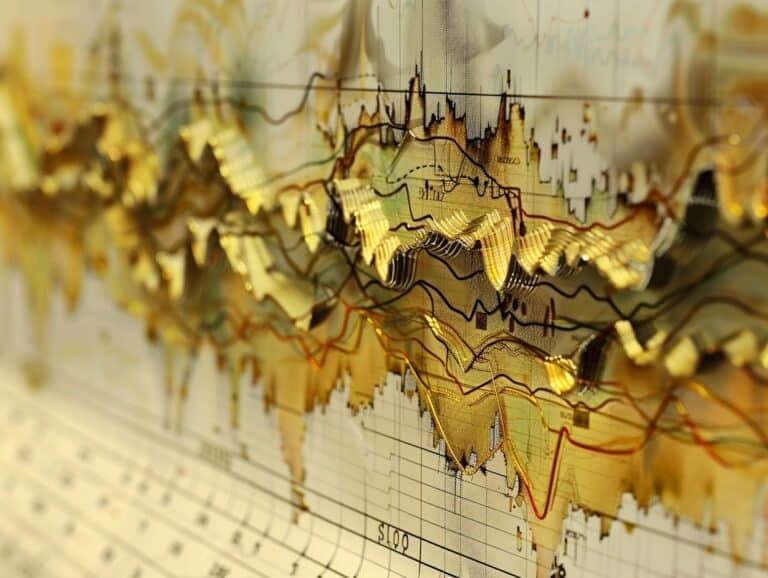Gold prices reached new heights, driven by the potential of an imminent interest rate cut by the Federal Reserve amidst emerging market movements and geopolitical uncertainties.
Short Summary:
- Gold prices hit a new record high at $2,481.09 per ounce.
- Expectations of a Federal Reserve interest rate cut in September boost the precious metal.
- Economic data points to a cooling U.S. economy, reinforcing market sentiment for lower rates.
In an extraordinary turn of events, the price of gold surged to unprecedented levels, topping $2,481.09 per ounce. This surge, reported on Wednesday morning, marks a significant milestone, driven by escalating anticipation that the Federal Reserve will initiate interest rate cuts as early as September. This prospective monetary policy shift is underscored by comments from key Fed officials and a series of economic indicators pointing towards a cooling U.S. economy.
The spot price of gold climbed to a historic peak of $2,481.09 per ounce, while U.S. gold futures reached a similar zenith at $2,482.00 per ounce. This bullish momentum in gold is primarily attributed to market expectations of a policy shift in the Federal Reserve’s interest rates, with traders overwhelmingly betting on a cut.
“Gold reached a new high watermark as investors position for the arrival of a lower interest rate environment. The $2,500 is the next immediate target, though if the current momentum can be sustained we could be looking at prices further north from here before year-end,” remarked Tim Waterer, KCM Trade’s chief market analyst.
Market data, including the CME FedWatch Tool, indicates a high likelihood of at least a 25 basis point rate cut in the upcoming September meeting. The tool reflects market participants’ expectations, with more than a 90% probability of a cut. Fed Chair Jerome Powell and other officials have contributed significantly to this optimism. At an event on Monday, Powell noted that recent inflation data has bolstered confidence that price pressures are easing. He hinted at potential rate cuts even before reaching the central bank’s 2% inflation target, further fueling hope among investors.
According to Jateen Trivedi, VP Research Analyst – Commodity and Currency at LKP Securities, the trend is driven by lowering inflation metrics from the previous week, reinforcing the prospect of rate reductions. He observed,
“Gold prices saw positive movement as interest rate cut expectations increased among buyers, driven by lower inflation data last week. This has influenced the Fed watch tool towards the possibility of rate cuts rather than holding rates longer.”
Additionally, economic data such as muted retail sales figures contributes to the narrative of a decelerating U.S. economy. While retail sales data was marginally higher than expected, it still pointed to an overall cooling, supporting the likelihood of easing financial policies.
The potential reduction in interest rates stands to make gold—a non-yielding asset—more appealing. Lower interest rates tend to reduce the opportunity cost of holding gold instead of interest-bearing assets such as Treasurys. Moreover, lower rates usually exert downward pressure on the dollar, enhancing gold’s attractiveness further. Gold often acts as a hedge against economic and geopolitical uncertainties, making it a coveted asset in times of turmoil.
Mark Stroud, Financial Analyst at Global Commodity Research, stated,
“Gold continues to trade positively, supported by a steady dollar and easing bond yields as focus remains on an early rate cut by the Federal Reserve. The bullion was also supported by a rise in safe-haven demand amid signs of political uncertainty in the U.S. and France, and with a close eye on the geo-political developments in the Middle East as well.”
The above is echoed by San Francisco Federal Reserve Bank President Mary Daly, who expressed confidence on Monday that inflation rates are aligning more closely with the Federal Reserve’s 2% target, which would justify a rate cut. Monitoring such dovish remarks, traders and analysts almost uniformly expect rate reductions in September.
Such sentiment and speculation were further boosted when Fed Governor Adriana Kugler expressed cautious optimism that inflation is approaching the Federal Reserve’s target. The convergence of these viewpoints among Fed officials strengthens the collective market belief in impending rate cuts.
Additionally, gold’s performance in 2024 surpasses many other assets. According to the World Gold Council, the first quarter saw global official gold reserves rise by 290 metric tons, the largest increase since 2000—a clear indicator of gold’s growing appeal.
These market dynamics are further influenced by geopolitical factors, such as political uncertainties in major economies like the United States and France, as well as ongoing tensions in the Middle East. Investors typically turn to gold during such times, capitalizing on its reputation as a safe-haven asset.
The SPDR Gold Trust, the largest gold-backed exchange-traded fund in the world, reported an increase in its holdings by 0.66% to 842.02 tonnes, a notable jump from 836.53 tonnes just a day earlier. This spike in holdings is yet another testament to the prevailing bullish sentiment surrounding gold.
It’s also worth noting that other precious metals have mirrored gold’s upward trajectory due to the weakening dollar. Spot silver, although relatively stable, notched a slight climb to $31.29 per ounce, whereas platinum edged up to $1,001.83 per ounce. Meanwhile, palladium experienced a 0.4% gain, reaching $962.69 per ounce. Notably, among these, silver has demonstrated a more robust performance in recent months compared to gold.
In summary, the current landscape for gold prices appears incredibly promising, underpinned by strong market sentiment geared towards an impending rate cut by the Federal Reserve. This potential policy shift is strongly supported by a plethora of economic data pointing towards easing inflation and a cooling U.S. economy. The combination of these factors, alongside geopolitical uncertainties and investor behavior, makes the case for sustaining high gold prices in the foreseeable future.
Altogether, these elements contribute to a compelling narrative of gold’s continued viability as a top-performing asset class, capable of providing stability amidst financial market fluctuations.
Authors & Disclosures
- Our content is independently written and reviewed by trusted reviewers & fact-checkers.
- We can earn money by connecting you with top Gold IRA Companies. Learn how our reviews work.
- Want to learn more? Meet our authors and explore our editorial policy.







